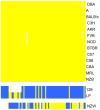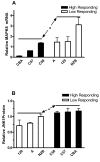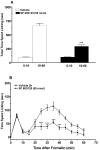Expression genetics identifies spinal mechanisms supporting formalin late phase behaviors
- PMID: 20149257
- PMCID: PMC2831877
- DOI: 10.1186/1744-8069-6-11
Expression genetics identifies spinal mechanisms supporting formalin late phase behaviors
Abstract
Background: Formalin injection into rodent hind paws is one of the most commonly employed pain assays. The resulting nocifensive behaviors can be divided into two phases differing in timing, duration and underlying mechanisms. Spinal sensitization has long been felt to participate in the second phase of this response, although this sensitization is incompletely understood. By using correlative analysis between spinal gene expression and mouse strain-dependent intensity of late phase behavior, we hypothesized genes participating in variability of the response could be identified.
Results: Late phase formalin behavior scores among 10 inbred mouse strains were correlated with a spinal cord gene expression database constructed using expression arrays. Messenger RNA levels for several genes were highly correlated with the late phase behavioral responses. Most of these genes had already been implicated in mechanisms regulating pain and analgesia. One of the most strongly correlated genes, Mapk8 coding for c-Jun N-terminal kinase 1 (JNK1), was chosen for further analysis. Studies using additional strains of mice confirmed that spinal cord mRNA expression levels of Mapk8 followed the pattern predicted by strain-specific levels of formalin behavior. Interestingly, spinal cord JNK1 protein levels displayed an inverse relationship with mRNA measurements. Finally, intrathecal injections of the selective JNK inhibitor, SP600125, selectively reduced late phase licking behavior.
Conclusions: Wide differences in pain behaviors, including those resulting from the injection of formalin, can be observed in inbred strains of mice suggesting strong genetic influences. Correlating levels of gene expression in tissues established to be mechanistically implicated in the expression of specific behaviors can identify genes involved in the behaviors of interest. Comparing formalin late phase behavior levels with spinal cord gene expression yielded several plausible gene candidates, including the Mapk8 gene. Additional molecular and pharmacologic evidence confirmed a functional role for this gene in supporting formalin late phase responses.
Figures




Similar articles
-
Intrathecal RGS4 inhibitor, CCG50014, reduces nociceptive responses and enhances opioid-mediated analgesic effects in the mouse formalin test.Anesth Analg. 2015 Mar;120(3):671-677. doi: 10.1213/ANE.0000000000000607. Anesth Analg. 2015. PMID: 25695583
-
Pain behavior in the formalin test persists after ablation of the great majority of C-fiber nociceptors.Pain. 2010 Nov;151(2):422-429. doi: 10.1016/j.pain.2010.08.001. Epub 2010 Sep 15. Pain. 2010. PMID: 20832171 Free PMC article.
-
Glutamate-evoked release of adenosine and regulation of peripheral nociception.Neuroscience. 2004;127(1):1-11. doi: 10.1016/j.neuroscience.2004.04.012. Neuroscience. 2004. PMID: 15219663
-
Characterization of nociceptive responses and spinal releases of nitric oxide metabolites and glutamate evoked by different concentrations of formalin in rats.Pain. 2001 May;92(1-2):107-15. doi: 10.1016/s0304-3959(00)00476-0. Pain. 2001. PMID: 11323132
-
Alterations in spinal cord gene expression after hindpaw formalin injection.J Neurosci Res. 2004 Nov 15;78(4):533-41. doi: 10.1002/jnr.20274. J Neurosci Res. 2004. PMID: 15389827
Cited by
-
Analgesic and Anti-Inflammatory Activities of Diethyl Ether and n-Hexane Extract of Polyalthia suberosa Leaves.Evid Based Complement Alternat Med. 2018 Jan 23;2018:5617234. doi: 10.1155/2018/5617234. eCollection 2018. Evid Based Complement Alternat Med. 2018. PMID: 29599807 Free PMC article.
-
The nicotinic α6 subunit gene determines variability in chronic pain sensitivity via cross-inhibition of P2X2/3 receptors.Sci Transl Med. 2015 May 13;7(287):287ra72. doi: 10.1126/scitranslmed.3009986. Sci Transl Med. 2015. PMID: 25972004 Free PMC article.
-
Next-generation computational genetic analysis: multiple complement alleles control survival after Candida albicans infection.Infect Immun. 2011 Nov;79(11):4472-9. doi: 10.1128/IAI.05666-11. Epub 2011 Aug 29. Infect Immun. 2011. PMID: 21875959 Free PMC article.
-
Evaluation of phenoxybenzamine in the CFA model of pain following gene expression studies and connectivity mapping.Mol Pain. 2010 Sep 16;6:56. doi: 10.1186/1744-8069-6-56. Mol Pain. 2010. PMID: 20846436 Free PMC article.
-
Antipyretic, Antinociceptive, and Anti-Inflammatory Activities from Pogostemon benghalensis Leaf Extract in Experimental Wister Rats.Medicines (Basel). 2019 Sep 20;6(4):96. doi: 10.3390/medicines6040096. Medicines (Basel). 2019. PMID: 31547083 Free PMC article.
References
Publication types
MeSH terms
Substances
Grants and funding
LinkOut - more resources
Full Text Sources
Other Literature Sources
Medical
Research Materials
Miscellaneous

